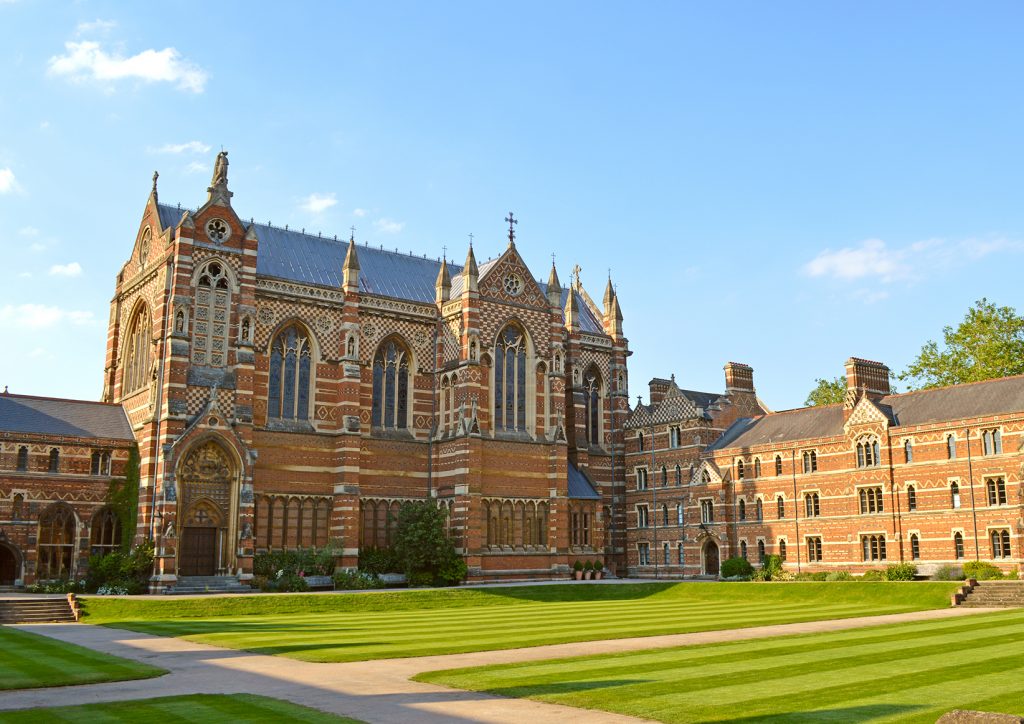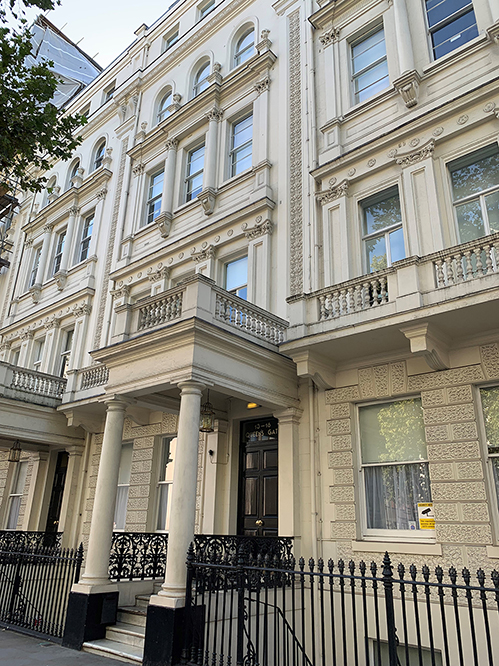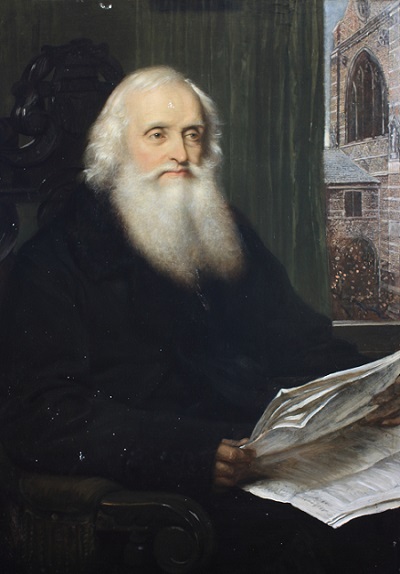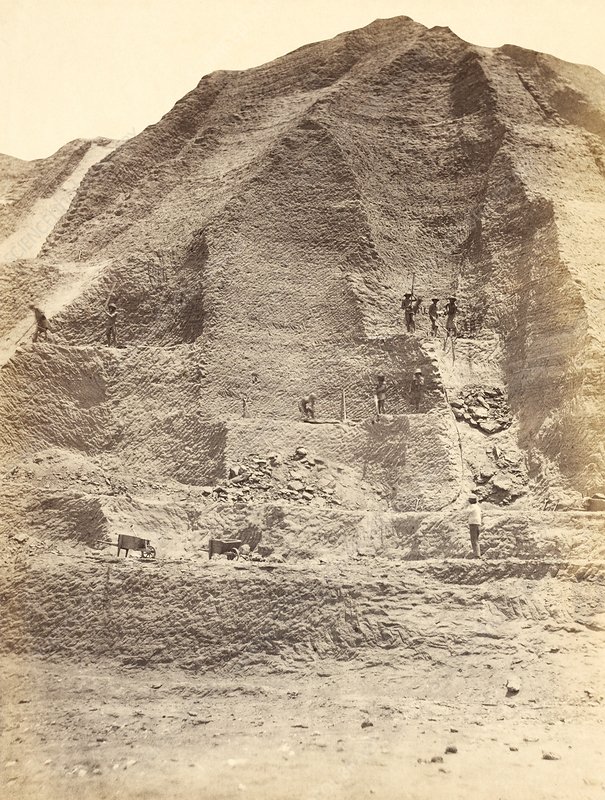History Features
Keble and the Colonial Legacy

This account has been compiled by Dr Ian Archer as part of the Oxford and Colonialism project.
Foundation of Keble:
supporters and subscribers
When Keble opened its doors in 1870, it was the first college to have been established since the early eighteenth century. It was founded in memory of John Keble, a leading figure in the Oxford Movement, which sought to reinvigorate the catholic traditions of the Church of England, but also the author of the best-selling collection of verse, The Christian Year (1827), which gave his reputation a global reach within the Anglosphere. Friends of Keble had for some time harboured the ambition of founding a new college on ‘economical’ principles to make an Oxford education available to people of more humble means. This was not exactly ‘access’ as we understand it, but it was part of an effort to open up Oxford to the middle classes. The other remarkable thing about the project was that whereas other colleges had usually been established by endowments from wealthy individuals, Keble was founded on the basis of public subscription. Within weeks of Keble’s death on 29 March 1866, it was decided to raise £50,000 by way of a memorial. The campaign used sophisticated fund raising tactics with a public media campaign backed by a network of local supporters who were issued with printed subscription cards. Although the full amount was not raised, the achievements were quite impressive. Within a year, nearly £30,000 had been raised from over 1,300 individuals. It was a campaign with a global reach; there were donors from the USA, Canada, India, South Africa, and Australia. Among the clerical subscribers were the bishops of Calcutta (two guineas), Fredericton (£5), and Cape Town (£25).
British participation in the slave trade had been outlawed in 1807; its slaves had been emancipated in 1833. Keble’s fund raising took place a generation later. Does that make its money clean? There is not a straightforward answer. There is no evidence that Keble’s donors had actively participated in the slave trade, but some of them had inherited wealth derived from slave plantations, and tracing those connections is not a straightforward task. Something of the complexities can be seen in the record of William Ewart Gladstone, future Prime Minister, which has attracted a degree of recent press attention. Gladstone himself donated £200 (one of the larger sums) to the subscription campaign, but his role goes beyond that. It was Gladstone who within days of John Keble’s death had suggested to the priest’s close friend H P Liddon, canon of St Paul’s Cathedral, that the college should be an appropriate memorial; Gladstone was approached to be a member of the fund raising committee, but declined because of pressure of other business; and his association with the college in its early years was especially strong because of his niece, Lavinia Lyttleton married Keble’s first Warden, Edward Talbot. Gladstone spent a lifetime as a champion of the liberty of oppressed peoples, and yet on the question of slavery his record is unimpressive. He was compromised by the fact that he had inherited wealth from his father, John Gladstone, who owned large plantations (valued at £336,000 in 1833, over half his assets) in the West Indies. William had not opposed emancipation as such, but argued for a phased approach in which moral emancipation through proper Christian education would precede physical emancipation, a conservative view which was widely criticised at the time. And in a clear conflict of interest he had also very actively lobbied on behalf of the plantation owners for compensation. Although he had a consistent record of opposition to the international slave trade, he did not back coercive means to curb it, preferring to rely on persuasion. It is true that in later life, he acknowledged the evil of slavery, but it is clear that he did not abandon fundamentally racist principles arguing as late as the 1870s that blacks were a ‘race of lower capacities’, a prejudice that was common but, it is important to realise, already contested.

Shaw-Stewart residence, Queen’s Gate, London
We have not been able to survey all the subscribers for their connections to slavery, and given the accidents of inheritance patterns it would be a tricky operation. But initial searches on the Legacies of British Slave Ownership website (https://www.ucl.ac.uk/lbs/) for some of the lead players in Keble’s story throws up some other instances. Montague Bernard, professor of international law at All Souls, who subscribed £100 and played a leading role on the College’s first Council had inherited between £1,000 and £1,500 from the profits of his father’s Eden estate in Jamaica. The leading lawyer, Roundell Palmer, later earl of Selborne and lord chancellor, who donated £500, one of the largest sums, was the son of the clergyman, William Jocelyn Palmer who with his merchant brothers had received nearly £3,000 in compensation claims. Perhaps most striking is the case of John Archibald Shaw-Stewart, who acted as treasurer to the original fund raising campaign, subscribed for £100, joined the first College Council, and became Bursar of the college in 1876. He was the son of Sir Michael Shaw-Stewart, 6th baronet of Ardgowan House, a member of the anglicized Scottish aristocracy, who had extensive estates in Trinidad and Tobago, and who as MP for Renfrewshire campaigned actively for compensation, while sharing Gladstone’s position on a gradualist approach to emancipation. The Bursar’s sister, the widow of The Honourable Robert Bruce, and a woman of the bedchamber to Queen Victoria, was the largest female subscriber at £300. It needs to be emphasised that most donors appear to have no connection to inherited slave wealth. The family of Frederick Lygon, Earl Beauchamp, at £5,000 the largest lay donor, owed its wealth to a huge windfall at the death of the miserly financier William Jennens (d. 1798), who preyed on the gambling addictions of the fashionable elite to make his money. Keble’s patron, the arch reactionary tory squire Sir William Heathcote (subscribing at £500), was a Hampshire landowner who profited from sales of timber to the Royal Navy. But the cases that we have uncovered are probably not exhaustive, and testify to the degree to which emancipation failed to remove the taint of wealth derived from slavery, while Heathcote’s case reminds us of the other ways in which the wealth of the landed elite was related to the larger imperial project.
The Gibbs benefaction
When the College opened in 1870, it consisted of two accommodation blocks of what is now Liddon Quad, and the entrance gateway; the chapel and kitchen block were temporary structures. The completion of the College owes a great deal to the extraordinary benefactions of one family, the Gibbses of Tyntesfield. In 1872, William Gibbs (1790-1875) who had supported the initial campaign with a gift of £500, undertook to pay for the cost of the Chapel, a donation worth something between £25,000 and £30,000. When the Chapel was opened on St Marks Day 1876, shortly after William’s death the previous year, his sons Antony and Martin promised the money for the construction of the Hall and Library, probably an equivalent sum. In other words, this single family had contributed as much as the initial fund raising campaign in its entirety. The Gibbses were sympathetic to the goals of the Oxford Movement, and gave large sums to church and school building across England. But their benefaction further complicates our understanding of the forms of exploitation on which mid-nineteenth-century British commercial supremacy rested.

Portrait of Williams Gibbs
The foundations of William’s business career had been laid in Spain where he actively traded in British and imperial commodities before diversifying into the South American trades, particularly Peru from 1822. In 1842 the firm’s local agents negotiated the first of several contracts for the export of guano, bird droppings rich in nitrates, from the Chincha Islands. William had initially thought the contract very unwise, but he was to be proven wrong as guano became the crucial agricultural fertiliser around the world; the Gibbses enjoyed a virtual global monopoly between 1847 and 1861, and by the 1850s profits were running at a staggering £100,000 per annum.

Guano extraction, Chincha Islands, Peru
The Gibbs benefaction poses various challenges. The firm’s operations in Peru can be seen as an example of the working of informal empire, whereby British interests used their financial muscle to subordinate foreign governments to their agenda. By bankrolling the unstable Peruvian regime through a series of loans, the Gibbses were able to maintain their commercial supremacy, and their monopoly position retarded Peruvian economic development. The most thorough examination of this issue to date seems to exonerate the Gibbses by suggesting that the Peruvian government was able to extract more favourable terms from successive contracts. It has even been claimed that the loans provided the means for stabilising Peru under the liberal regime of Ramon Castilla in the 1840s, and facilitated the abolition of slavery. But the other issue is much more problematic. By the 1850s the guano was being mined predominantly by Chinese bonded labour (disparagingly known as ‘coolies’), up to 700 at a time, on three to five year contracts. The labourers had often been coerced into their contracts (their labour being the repayment for the ‘loan’ of the costs of their transport across the Pacific), working conditions were appalling, and rates of suicide high. Although the contracts were supposedly fixed term, debt peonage made many of them essentially permanent. It is true that for the bulk of the period the Gibbses were not directly involved in the guano mining process (and for the brief period that they were working conditions were slightly ameliorated), but they would have been well aware of what was going on, not least because of unfavourable press coverage: things were so bad that in 1854 nine of the ships’ captains carrying the guano petitioned the British government, resulting in a ban on the use of British ships for the transport of the Chinese across the Pacific. The ‘coolie’ system was eventually abolished as a result of international and humanitarian pressure in 1874, but it continued to underpin white wealth based on guano, sugar and railroad construction into the 1890s. The experience of the Chinese labourers on the Chincha Islands reminds us of the variety of ways that coerced labour manifests itself both in the past and the present.
Keble and empire
Empire cannot be ignored in Keble’s history for the simple reason that so many of its students went to work in it. When Keble opened its doors in 1870, there were just 31 students. Of those four spent most of their careers in the empire. R S Abraham, up for just two terms, was unusual in opting for the private sector, pursuing a career in banking in New Zealand. More typical of Keble men were those who pursued clerical and educational careers. G D Oswell ended as Principal of Rajkumar College, Raipur, intended for the education of the children of the indigenous elites; his value system emerges in his five volume Sketches of Rulers of India, a pretty horrific apologia for British rule, but probably representative of the values of his class. Perhaps less controversial was W E Scott, ordained in 1877 who after a few years of parochial ministry in northern England moved to India in 1885, serving as archdeacon of Bombay until returning to England in 1907. The Yorkshireman H C Sanderson, who has the distinction of being the first Keble graduate, was Superior of the Anglican missionary brotherhood of St Augustine Modderpoort from 1894 to 1905 (which was soon to develop a programme for the education of black teachers, and later found itself at odds with the Apartheid regime), and ended his career as Superintendant of Missions in the Orange Free State. Others of the 31 contributed to the Keble global diaspora beyond the empire. A E Bernays and E C Paget both pursued clerical careers in the USA, though Bernays died in Bombay soon after his arrival on missionary work in 1910; while another, A F Guillemard became a railway engineer in South America after training in Spain.
We are fortunate in having good data on this phenomenon as a result of Richard Symonds’ analysis of the Keble College Register (1970), a remarkable prosopographical tool which today’s data protection laws make impossible to contemplate. Symonds’ analysis of the data show that throughout the period up to the Second World War 20 per cent of Keble’s students went on to spend at least two years working in the empire. This was rather more than St Johns, and rather fewer than Balliol. But the career destinations of Keble men (and they were all men) varied significantly. In the period up to 1914, 43% of Keble men working in the empire were destined for religious careers, and 14.5% for the world of education, whereas for Balliol men, the figures are 4% and 13% respectively. Balliol men dominated the colonial bureaucracy: 50% entered the Indian Civil Service, 11% the Colonial Services, and 2% the Dominion Services. Among Keble men, the proportions were 8% for the ICS, 13% for the Colonial Services and none in the Dominion Services. The pattern shifted in the period between the wars, when political reforms, power sharing, and increasing dissent made the imperial administration less attractive to the British elites; there was significantly more recruitment from grammar school boys. Keble men in the empire were now slightly less likely to pursue religious careers (31%), and more likely to go into the educational sector (22%). The numbers overall in the imperial bureaucracies rose to 32%, with the most significant growth being in recruitment to the Colonial Services (23%).
Keble played a leading role in Oxford’s missionary work, and its Anglo-Catholic traditions gave it a distinctive tone. The Oxford Mission to Calcutta established in 1880 drew on the monastic traditions of celibate religious communities; it was sponsored by people closely associated with the college, including H P Liddon, Charles Gore, and Henry Scott Holland. The Vice-Chairs of the Home Committee were the college’s successive Wardens, Edward Talbot and Robert James Wilson. Three Keble men served in the mission in its early years: C W Townsend, whose tenure as superior (1885-8) was brought to an end by his conversion to Roman Catholicism; H S Moore, who worked in Calcutta with the OMC from 1888-1894, before joining the Cowley Fathers and undertaking missionary work on their behalf in Bombay and Poona; and W P G Field whose varied career took him to Bengal, Yokohama, and a variety of English cures in his later years. It has been claimed that the Anglo-Catholic missionaries held more respect for indigenous traditions than some of their Evangelical rivals, and their commitment to the higher education of Bengali students put them at odds with the imperial establishment. But such sympathies were circumscribed by the baggage of imperial and Christian prejudice. Here is Talbot, Keble’s first Warden, now bishop of Rochester writing in the preface to the first history of the mission to Calcutta: ‘Now we must, by our education, do much to destroy India’s faiths. As Christian Englishmen we believe that we have a better faith to give, a faith which to speak only of its social sphere is of incomparably higher bonding power and wholesome effect’. In the event, whatever the educational successes, India proved to be the greatest site of missionary failure in terms of actual conversions. It is clear that much more work needs to be done on the missionary work of Keble men, for example in comparisons between different fields of missionary endeavour, and exploring the networks of Anglican association the College sustained.
Recruitment from the empire
We can see those networks in operation in the role played by the global Anglican network in bringing men to Keble from the empire. In the first decade of the twentieth century at least eighteen men from the British empire attended the College. This is likely to be a modest underestimate because it is based on data relating to schooling rather than residence (thereby excluding people form the colonies whose secondary education took place in Britain), but it shows the predominance of the white settler colonies. There were nine from South Africa, four from Australia, three from Canada, one from New Zealand, and one from Jamaica. The pattern of their educational backgrounds suggests that Anglican networking was in play. Of the South Africans, four were recruited from St Andrews Grahamstown in the Eastern Cape, founded by the Oxford Movement supporter, Bishop John Armstrong in 1855, and two from Rondebosch Diocesan College, founded by Robert Gray, first bishop of Cape Town in 1855. Keble’s first Rhodes Scholar, Cyprian Brooke who matriculated in 1903, was educated at Rondebosch; he was following in the footsteps of two of his brothers who had attended Keble in the mid-1890s, and he returned to teach at the Preparatory School at Rondebosch in 1922 where he spent the bulk of his career. The College’s second Rhodes Scholar, J M Nethersole, came from one of the white families in Jamaica, and pursued a successful legal career there.
Before the First World War Keble seems to have been a uniformly white institution. That changed during the inter-war period, but to a minimal extent. During the 1920s we see the continuation of the feeder stream from Grahamstown which provided another four Keble men. But there was now a trickle of students from Sir Lanka, at least ten over the course of the decade. Among the first, arriving in 1920, was Christopher Alan Hector Perera Jayawardana (1898-1986), schooled at Trinity College in Kandy (another Anglican missionary foundation), who undertook a Diploma in Forestry at Keble, and won a scholarship to proceed to a full degree. He pursued a distinguished career in the Forestry administration in Sri Lanka and was active in the scouting movement. He ascended the British honours system and became an equerry to Queen Elizabeth II in 1954. The Sri Lankan recruits are an interesting group, several of whom seem to reflect the mixed ethnicities arising from the overlaying of Dutch and British colonial encounters with the indigenous population, but more work needs to be done, preferably with more local sources. One of the challenges of recovering the lives of these people is the skewing of the immediately available sources to a metropolitan perspective.
Sir James Cameron Tudor (1919-95) was to our knowledge the first person of African Caribbean descent to study at Keble. Born and educated in Barbados, he came to the college in 1940 to study Philosophy, Politics and Economics. He was active in the University Labour Club and served as Treasurer of the Junior Common Room Committee in 1941 – 1942, Secretary in 1942 – 1943 and was elected, unopposed, as President for 1943 – 1944. During his tenure as President, he oversaw the JCR through a difficult time, during which the College was requisitioned for war purposes and the students were rehoused in other colleges. He was the first President of African Caribbean descent of the Oxford Union in 1942 – 1943 where he was described as having ‘exercised in the Chamber a pleasant and astringent wit’. He subsequently became one of the Caribbean’s most influential diplomats and politicians. He was a founding member the Democratic Labour Party of Barbados, which led the country to independence in 1966. He served as Deputy Prime Minister, Education Minister, High Commissioner to Britain, and Ambassador to the United Nations. In 2018 the College commissioned a posthumous portrait by the artist Antony Oakeshett, which at the time of writing hangs in the Dining Hall.
Work in progress
This is very much an interim report. There is much more to be done on career destinations within the empire, and changing patterns of recruitment from overseas. We need to research much more fully the changing patterns of recruitment, both of students and staff, over the twentieth century. There are, we think, possibilities for dissertations on the work of the missionaries. We would very much welcome corrections, and information from anyone who might have Keble people among their ancestors, particularly those with experiences of empire. This might help us to address the ‘metropolitan’ bias of our archive.
Thanks
This account has been compiled by Ian Archer, who would like to thank Maria Misra, Angus Hawkins, and Lesley Kinsley.
Further Resources
Keble College Archives include subscription lists, cards, and minute books for the Memorial Fund
A. Cameron and I. W. Archer (eds.), Keble Past and Present (London: Third Millenium Publishing, 2008)
Keble Heritage microsite: heritage.keble.ox.ac.uk, including talks from the Keble 150 Symposium
L.J. Kinsley, ‘Guano and British Victorians: An Environmental History of a Commodity of Nature’ (University of Bristol Ph.D. thesis, 2020)
Legacies of British Slavery database: www.ucl.lbs.ac.uk
G. Longridge, A History of the Oxford Mission to Calcutta (n.p.: John Murray, 1900)
W.M. Mathew, ‘Foreign Contractors and the Peruvian Government at the Outset of the Guano Trade’, Hispanic American Historical Review, 52:4 (1972), 598-620
W.M. Mathew, The House of Gibbs and the Peruvian Guano Monopoly (London: Royal Historical Society, 1981)
Oxford Dictionary of National Biography
R. Quinault, ‘Gladstone and Slavery’, Historical Journal, 52:2 (2009), 363-83
G. Rowell, ‘”Training in Simple and Religious Habits”: Keble and its First Warden’, in M.G. Brock and M.C. Curthoys (eds.), The History of the University of Oxford, VII. Nineteenth-Century Oxford, Part 2 (Oxford: Oxford University Press, 2000), pp. 171-91
B. St. G. Drennan (ed.), The Keble College Centenary Register, 1870-1970 (Keble College, 1970)
W. Stewart, Chinese Bondage in Peru. A History of the Chinese Coolie in Peru (Durham: Duke University Press, 1951)
R. Strong, ‘The Oxford Movement and Missions’, in S.J. Brown, P.B. Nockles, and J. Pereiro (eds.), The Oxford Handbook of the Oxford Movement (Oxford: Oxford University Press, 2017), pp. 485-99
R. Symonds, Oxford and Empire: The Last Lost Cause? (Oxford: Oxford University Press, 1992)
